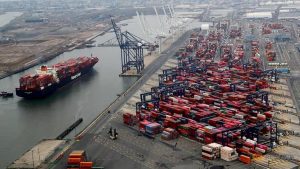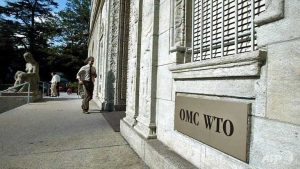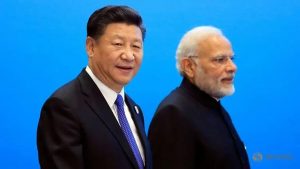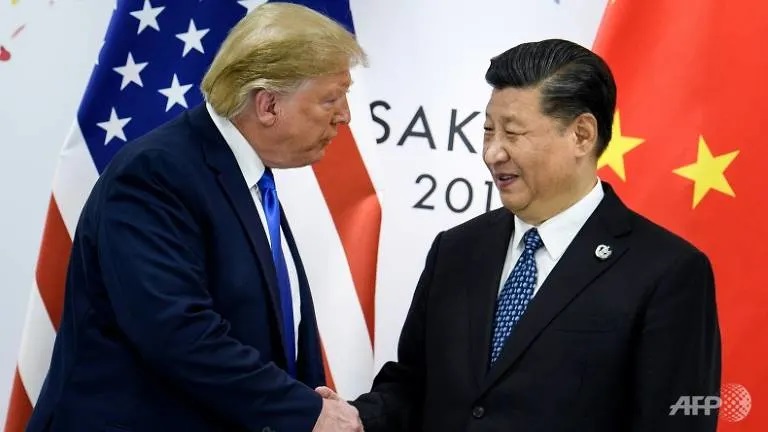In times of trouble, countries coming together to formalise trade are doing the right thing, says one observer.

A container ship is seen as hundreds of shipping containers are seen stacked at a pier at the Port of New York and New Jersey in Elizabeth, New Jersey, U.S., March 30, 2020.
CHRISTCHURCH: Did anyone notice that the United States–Mexico–Canada Agreement (USMCA), the revised North American Free Trade Agreement (NAFTA), entered into force on Jul 1?
If not, do not be too concerned, as the COVID-19 crisis has probably affected that as well.
Still, this deal is (without getting too much into the weeds of whether it is more or less liberal than NAFTA) one of the few examples we have of negotiated trade liberalisation in 2020.
We are now far enough into the COVID-19 crisis to realise that not only has the world changed, but also some of the concepts and structures which have underpinned global stability since the end of the Second World War are seriously weakened.
Look at global trade. In the period after 1945, led by the US, the international community made a commitment to expand global trade and to try to stop protectionism – which has wracked the 1930s – from becoming predominant again.
Nearly 50 years later, the conclusion of the Uruguay Round brought us to a point where it seemed as if global trade was a given in the way the world operated.
PANDEMIC INCREASED PROTECTIONISM
Now, 25 years later, things look very different. Much of the fraying of the trade rules has been happening for other reasons. But the coronavirus situation has highlighted what has happened and also made the way out of this mess much harder to see.
The pandemic has contributed to a climate in international relations where the first reaction is to think national. What’s the phrase? “All issues are global, but all politics is local.”
We have seen nationalism interfere with global trade in the very things needed internationally to combat the virus. We have seen the partial dismantling of global supply chains. We have seen the move towards domestic protectionism, described as “ensuring supply”, across a range of industries.
What we have not seen is much leadership in the international community about how to get trade rules back up and running. The World Trade Organisation (WTO) might be flawed in some ways, but it is the only organisation with an international mandate.
Work on reforms is underway, but without serious engagement from the US and China, things will limp along. The WTO currently is searching for a new director-general.
In these times of crisis, one would have hoped for a speedy identification of a suitable candidate who could bring some leadership to the issues. But it looks unlikely.

The entrance of the World Trade Organisation (WTO) headquarter in Geneva (Switzerland).
In this obvious deadlock at the global level, regional and bilateral free trade agreements, even if a lesser substitute, are all we have. That’s why the entry into force of the USMCA should be seen positively.
REGIONAL PACTS CAN WORK
In Australia and New Zealand, we have to be thankful that the Comprehensive and Progressive Agreement for Trans-Pacific Partnership (CPTPP) is up and running. Trying to negotiate that now would be well-nigh impossible. Had the US had not pulled out of it as the TPP, it would undoubtedly be stronger than it is.
But it functions and delivers results. This explains interest from the United Kingdom in doing free trade agreements with Japan, Australia and New Zealand. If the UK wants to join the CPTTP, as it says it does, it cannot get there without getting bi-laterals with three of CPTTP’s members.
We do know that in the pandemic-affected world, the Asia-Pacific will be a significant player in the regrowth of global trade flows. In the WTO’s most recent projection of global trade in the 2019–20 year (first quarter) will drop about 18.5 per cent.
Beyond first quarter 2021, the recovery should be better in the Asia-Pacific than in the rest of the world. IMF modelling suggests that the development of further trade liberalisation and regional economic integration could lead over time to a 10 per cent growth in Asian GDP.
China looks on present indications, to recover from its lowest annual growth rate in over 40 years. China is not, of course, a member of the CTTP.
It is leading the negotiation of its own version of a regional economic integration model, the Regional Comprehensive Economic Partnership (RCEP).
Participating countries are due to ratify this agreement at the end of this year, but the withdrawal of India from the process late last year has reduced the scope of RCEP significantly.

China’s President Xi Jinping and India’s Prime Minister Narendra Modi arrive for a signing ceremony during the Shanghai Cooperation Organization (SCO) summit in Qingdao, Shandong Province, China June 10, 2018.
In the current tense climate between Delhi and Beijing, Indian reintegration looks very unlikely.
Still, if ratification and entry into force go ahead, the region will have two similar trade agreements, neither of which the US plays a role in.
This is, quite frankly, a tragedy – not only strategically, but also because the US economy is a major participant in Asia-Pacific economic development. China gains from this absence.
In the meantime, the European Union and the UK, which would be interested in developing their trade relations with the region, are struggling with the damage caused by COVID-19 and post-Brexit relations. So not much to expect there.
Trade negotiators must think that theirs is an unhappy lot. But they keep trying. The latest effort, which may get somewhere, including with the US, is the Digital Economy Partnership Agreement launched by Singapore, Chile and New Zealand.
Trying to establish a framework in the digital era, the agreement touches on such things as artificial intelligence, data sharing and protection, and digital innovation. It deserves success.
Dick Grant was the Executive Director of the Asia New Zealand Foundation from 2008 to 2012. Prior to that he had been in the New Zealand Foreign Ministry for 40 years, serving, inter alia, as High Commissioner in London and in Singapore. This commentary first appeared on the Lowy Institute’s blog, The Interpreter.

